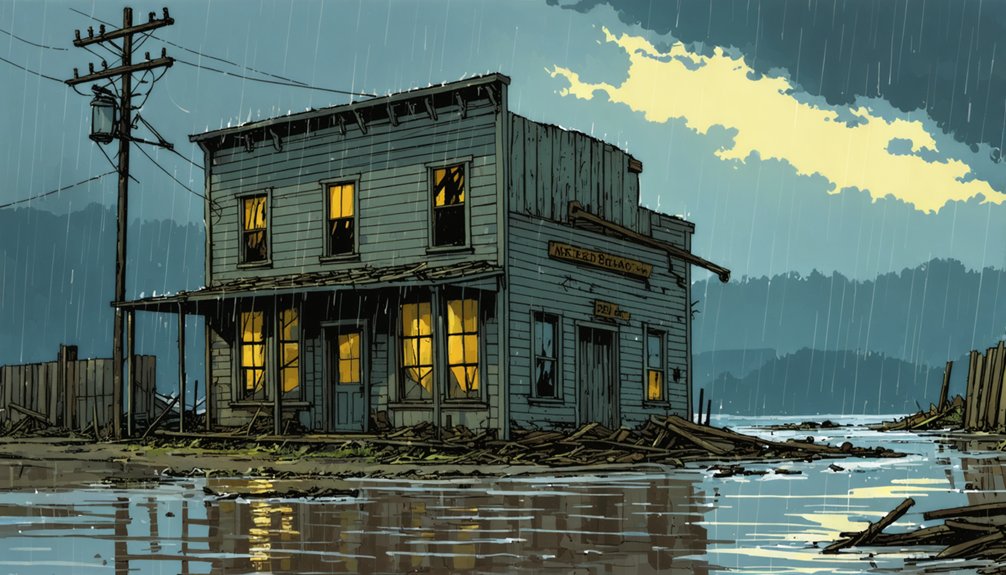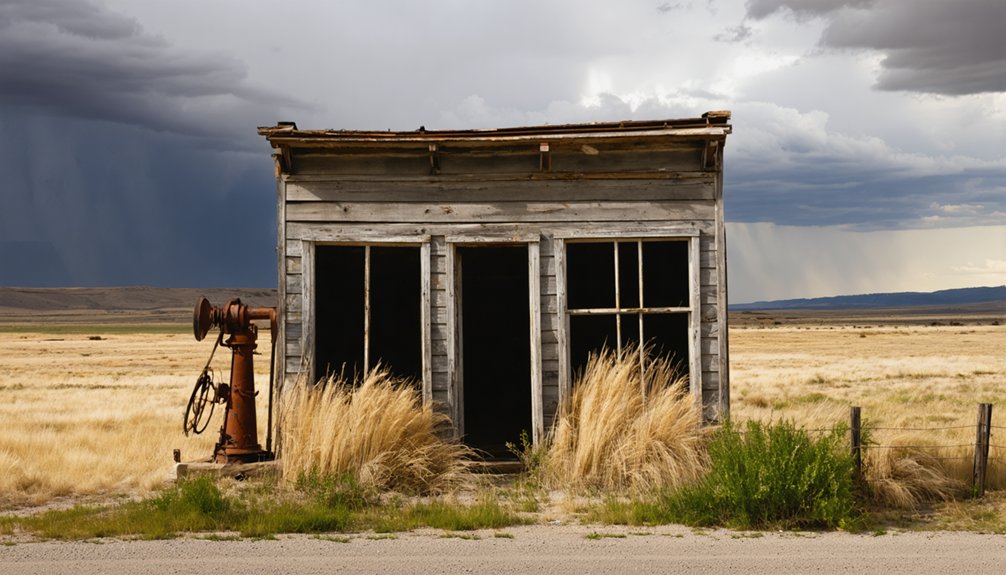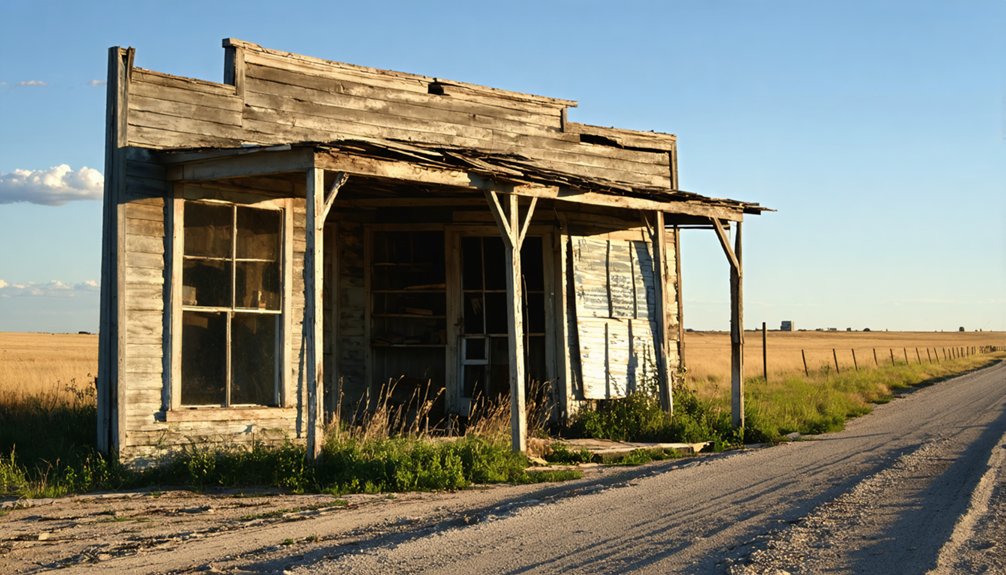You’ll find Folsom’s ghost town origins in its 1886 founding as a railroad stop, named after Frances Folsom Cleveland. The town flourished briefly until a catastrophic 1908 flood claimed 17 lives, including heroic telephone operator Sally Rooke who stayed behind to warn others. Most residents never returned, and declining rail transport sealed Folsom’s fate. Today, you can explore scattered foundations and deteriorating structures that tell the story of this once-thriving Black Hills community.
Key Takeaways
- Folsom transformed from a thriving railroad town to a ghost town after devastating floods in 1908 killed seventeen residents.
- Named after Frances Folsom Cleveland, the town’s population declined to fewer than 30 residents by the early 1900s.
- Most original structures are now roofless or severely deteriorated, with foundations hidden beneath overgrown vegetation.
- The railroad’s decision to bypass Folsom, combined with mining decline and harsh prairie conditions, led to its abandonment.
- The heroic sacrifice of telephone operator Sally Rooke during the 1908 flood marks a turning point in Folsom’s decline.
The Origins of Folsom’s Name
When Frances Folsom Cleveland stepped off a train during a whistle stop visit in the late 1800s, she left such an impression on local residents that they named their burgeoning settlement after her.
A First Lady’s brief train stop in the 1800s inspired a small town to adopt her name as their own.
You’ll find that the Folsom naming occurred during a time of westward expansion, when the area was evolving from a tent city known as “Rag Town” to an established railroad stop. Like many ghost town communities, Folsom’s development was closely tied to the arrival of the railroad.
The settlement’s previous incarnation as Madison had been bypassed by the railroad, leading to a fresh start at the river crossing. In 1886, the post office officially adopted the name Folsom, cementing the town’s connection to the First Lady. For researchers seeking information about Folsom’s history, multiple disambiguation pages exist to help navigate various Folsom-related topics.
While other American towns share the Folsom name, you’ll discover that South Dakota’s Folsom uniquely honors Frances Cleveland’s maiden name.
Early Settlement and Pioneer Life
As Euro-American pioneers first ventured into the Folsom region in the late 1870s, they established homesteads in the water-rich valleys ideal for ranching and farming.
Among the earliest settlers, families like the Slacks, Johnsons, Eversons, and Yorks faced pioneer struggles that tested their resolve. You’d have found them living in basic log cabins or shacks, relying on hunting and livestock for survival. This period coincided with the start of the Great Dakota boom in 1877. Archaeological evidence shows that Paleo-Indian hunters had occupied these same valleys thousands of years earlier.
William York’s homestead became a lifeline for the growing community, serving as a store, post office, and lodging house, while his wife provided essential medical care as a midwife.
Despite the isolation and limited access to supplies, community resilience emerged through mutual support networks. Settlers traded goods at local posts, shared resources, and gradually built the foundations of a connected community through mail routes and postal services by the mid-1880s.
Railroad’s Role in Town Development
The arrival of the Sacramento Valley Railroad in 1856 marked a defining chapter in Folsom’s story, establishing it as a pioneering hub in American rail history west of the Mississippi River. The railroad impact transformed the town’s landscape, with the depot at 200 Wool Street becoming the heart of local commerce and communication.
You’ll find the economic transformation was swift and far-reaching. The rail line brought a surge of visitors and settlers while enabling essential services like mail delivery and telegrams. Like many South Dakota towns of the era, Folsom followed a T-shaped layout with its main commercial avenue running perpendicular to the tracks.
Local agriculture flourished as farmers gained access to broader markets through new grain elevators and warehouses along the tracks. Hotels, shops, and services sprang up around the depot, creating a bustling commercial district that defined Folsom’s growth until the post-World War II decline of rail transport nationwide. After being acquired by the city from Southern Pacific in 1970, the historic depot began its transition into a cherished community landmark.
The Sawmill Era and Economic Growth
During the Black Hills settlement boom of the 1870s, lumber operations emerged as Folsom’s economic backbone, with sawmills processing vast stands of Yellow Ponderosa pine for regional development. Like early pioneers such as W.H.C. Folsom who built logging enterprises in other frontiers, the sawmill operators helped establish crucial infrastructure.
The sawmill significance extended beyond basic lumber production, creating jobs in logging, milling, and transportation while supporting the region’s gold mining operations. By 1900, Custer County had become a major timber processing hub.
You’ll find that the lumber economy diversified Folsom’s prospects beyond mineral extraction, as timber resources supplied construction materials for homes, businesses, and mine shoring.
- Multiple sawmills operated throughout the Black Hills region
- Clear-cutting practices supplied timber for rapid infrastructure growth
- Lumber supported construction of bridges, forts, and warehouses
- Transportation networks developed to move timber products efficiently
- Sawmill operations provided steady employment outside of mining work
Natural Disasters That Shaped Destiny
While Folsom showed promise as a thriving lumber settlement, nature dealt a devastating blow in 1908 when an intense cloudburst triggered catastrophic flooding.
You’ll find that the town’s lack of flood preparedness became evident as hay and debris clogged railroad bridges, creating makeshift dams that later burst with devastating force. The resulting surge washed away most buildings that weren’t properly anchored, claiming seventeen lives, including telephone operator Sally Rooke. Like many ghost towns of Dakota, Folsom’s remnants tell a haunting story of sudden abandonment and lost dreams. Much like the town of Ardmore, the community faced a lack of water that made rebuilding efforts nearly impossible.
The disaster shattered any hope of community resilience, as most residents chose not to return and rebuild. By the 1970s, Folsom’s population had dwindled to about eighty people, with its last store closing its doors.
Today, a monument near the Folsom Museum honors Rooke’s sacrifice during that fateful day.
Archaeological Treasures and Native Heritage
Long before nature’s fury reshaped Folsom’s destiny, this region held deep archaeological significance through its connection to North America’s earliest inhabitants.
You’ll find evidence of Paleoindian cultures who mastered sophisticated hunting techniques and crafted advanced stone tools across South Dakota’s landscape. While the town of Folsom isn’t directly linked to the famous Folsom points, the surrounding area reveals rich native culture heritage spanning thousands of years.
- Paleoindian hunters tracked giant bison through these lands
- Sophisticated fluted projectile points showcase advanced stone tool technology
- Archaeological sites throughout South Dakota tell stories of indigenous adaptation
- Ancient bison hunting grounds preserve clues to prehistoric life
- Native American cultural heritage continues to influence the region today
Life-Changing Floods and Heroic Acts

You’ll find that Folsom’s most dramatic moment came during a devastating flood when rushing waters tore through the town without warning.
In the early morning darkness, the town’s telephone operator spotted the approaching wall of water and began frantically calling residents to evacuate.
As she stayed at her switchboard making her final calls, she sacrificed her own life to save others, becoming one of South Dakota’s most memorable flood heroes.
Deadly Waters Strike Town
As dark clouds gathered over the Dry Cimarron river headwaters in 1908, Folsom’s residents couldn’t have predicted the devastating flood that would forever change their town.
Despite early flood warnings from upstream neighbors, the raging waters overwhelmed the community’s resilience. Heavy rain triggered a massive surge, with debris and hay stalks creating dangerous dams at railroad bridges. When these barriers burst, the destruction was catastrophic.
- Waters rose 3-4 feet deep on Main Street
- Buildings not anchored to foundations washed away
- Sarah J. “Sally” Rooke sacrificed her life warning others
- Eighteen residents lost their lives in the disaster
- Floodwaters carried massive amounts of debris through town
The flood’s aftermath proved insurmountable for Folsom. Many survivors never returned, and the population dwindled to about 80 people, marking the beginning of its decline toward ghost town status.
Telephone Operator’s Final Warning
The telephone operator’s final warning echoed through Folsom’s communication lines that fateful day, becoming a last lifeline for many residents caught in the flood’s path.
You’d have heard their urgent, clear voice repeating critical flood preparedness instructions, directing you to safe zones while coordinating with emergency crews. Despite overloaded lines and growing panic, their communication strategies remained focused and effective.
The operator’s persistent calls helped first responders locate trapped families and mobilize rescue operations. They stayed at their post until the very end, fighting through power outages and system failures to reach isolated homes.
While some remote areas proved difficult to contact, the operator’s calm, methodical approach saved countless lives, establishing a legacy that would transform emergency response systems across the region.
The Decline of a Frontier Town
As you explore Folsom’s decline, you’ll find the town’s fate was sealed by a perfect storm of economic hardships and environmental challenges.
You can trace the downward spiral to when the railroad bypassed the settlement, cutting off essential trade routes and triggering an exodus of residents seeking better opportunities elsewhere.
While harsh prairie conditions, including droughts and soil depletion, steadily eroded the remaining agricultural base, the population ultimately dwindled to fewer than 30 residents by the early 1900s.
Economic Forces Trigger Decline
When mining activity declined across South Dakota’s frontier towns in the late 1800s, Folsom’s economic foundation began to crumble alongside many of its neighboring settlements.
You’ll find that these economic shifts triggered a chain reaction – as mines closed, residents left in search of work elsewhere, creating a downward spiral that affected the entire region’s economy.
- Depletion of gold veins forced mine closures, eliminating primary jobs
- Railroad changes reduced crucial transportation connections
- Agricultural challenges converted farmland to less profitable ranching
- Young residents moved to larger cities for better opportunities
- Loss of population led to closure of essential services and businesses
Population trends show how the combination of mining’s decline, transportation changes, and agricultural hardships made it impossible for Folsom to sustain itself, ultimately leading to its abandonment like many other Black Hills communities.
Natural Disasters Seal Fate
Through a series of devastating natural disasters, Folsom’s already fragile frontier community faced insurmountable challenges that ultimately sealed its fate.
The town’s minimal infrastructure couldn’t withstand nature’s fury, particularly during the catastrophic flood of 1908 that claimed 18 lives. You’ll find that this disaster marked a turning point from which the town never recovered.
Climate impacts hit Folsom particularly hard due to its vulnerable location and lack of protective measures. Without adequate soil conservation and flood controls, the town faced ongoing environmental threats.
Infrastructure challenges mounted as buildings and roads deteriorated, making repairs increasingly difficult. The psychological toll on survivors, combined with the massive economic burden of rebuilding, led many residents to abandon their homes permanently, accelerating the town’s transformation into a ghost town.
Remaining Structures and Ghost Town Status

Despite extensive research into South Dakota’s ghost towns, specific details about Folsom’s remaining structures remain elusive.
Like many ghost town characteristics in the Black Hills region, you’ll likely find abandoned buildings in various states of decay. The common reasons for abandonment often stem from economic decline, particularly in mining communities, where depleted resources led to mass exodus.
Economic decline and depleted mines left Black Hills ghost towns scattered across South Dakota, their decaying structures frozen in time.
- Most structures you’ll encounter are roofless or severely deteriorated
- You may only find scattered foundations beneath overgrown vegetation
- The site might be monitored by a caretaker, as is common in South Dakota ghost towns
- You can explore the remnants as part of the region’s historical tourism
- The location represents a typical pattern of Black Hills abandonment
While specific details about Folsom are scarce, its ghost town status aligns with the regional pattern of abandoned settlements throughout South Dakota.
Historical Legacy in the Black Hills Region
Folsom’s historical legacy intertwines deeply with the rich cultural tapestry of the Black Hills region, spanning thousands of years before its establishment as a mining settlement.
You’ll find evidence of Paleo-Indian heritage at the nearby Jim Pitts site, where ancient stone tools reveal the area’s earliest inhabitants who hunted megafauna and later, giant bison.
The region’s Indigenous heritage faced dramatic upheaval when gold’s discovery in 1874 violated the Fort Laramie Treaty, transforming the sacred Lakota territory into a mining frontier.
Folsom emerged during this pivotal shift, as the mining impact reshaped the Black Hills’ cultural landscape.
While the town’s physical presence has faded, it stands as a symbol of the complex intersection of Native American displacement and the region’s rapid transformation during the late 19th century.
Frequently Asked Questions
Are There Any Paranormal Activities or Ghost Sightings Reported in Folsom?
Like a dusty page without ink, you won’t find documented ghost encounters or supernatural phenomena here. While this ghost town’s got plenty of history, there’s no credible record of paranormal activity.
What Happened to the Families Who Lived in Folsom After Leaving?
You’ll find family legacies scattered, as residents dispersed to nearby towns seeking stability. Though migration patterns aren’t well documented, most families independently sought economic opportunities in surrounding regional communities.
Can Visitors Legally Explore the Remaining Structures of Folsom Today?
You can’t legally enter structures without property owner permission. Due to exploration regulations and visitor safety concerns, it’s best to view from public roads or obtain explicit access authorization.
Were There Any Notable Crimes or Outlaws Associated With Folsom?
You won’t find documented outlaw history or crime legends here – historical records don’t show any significant criminal activity. The town’s significance stems from archaeological discoveries rather than Wild West lawlessness.
Did Folsom Have Its Own School System During Its Peak Years?
Like a lost page from history’s book, you won’t find evidence of a dedicated school system in Folsom’s peak years. Research into Folsom education and history suggests children likely attended schools elsewhere.
References
- https://coloradosghosttowns.com/Folsom NM.html
- https://www.youtube.com/watch?v=4kuMIfUFk8w
- https://www.sdpb.org/rural-life-and-history/2023-08-21/some-black-hills-ghost-towns-and-their-origins
- https://www.powderhouselodge.com/black-hills-attractions/fun-attractions/ghost-towns-of-western-south-dakota/
- https://www.youtube.com/watch?v=_0WNYsFLSLA
- https://history.sd.gov/archaeology/past.aspx
- https://en.wikipedia.org/wiki/List_of_ghost_towns_in_South_Dakota
- https://pitsenberger.com/blog/category/Ghost+Towns
- https://www.sdhspress.com/journal/south-dakota-history-2-2/some-black-hills-ghost-towns-and-their-origins/vol-02-no-2-some-black-hills-ghost-towns-and-their-origins.pdf
- https://en.wikipedia.org/wiki/Folsom



